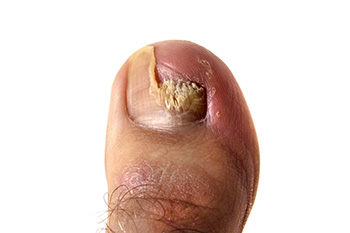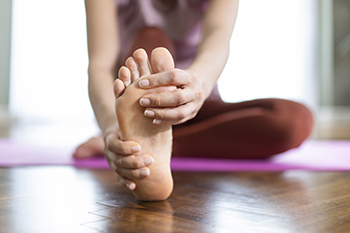
Thick toenails are often a sign of toenail fungus, a common infection caused by fungi thriving in warm, moist environments like sweaty shoes or public pool areas. The infection usually begins with a small discoloration that gradually spreads, causing the nail to thicken and become brittle. Symptoms include yellowing or whitening of the nail, crumbling edges, and an unpleasant odor. The thickened nail may become painful or difficult to trim, and, in severe cases, it can separate from the nail bed. A podiatrist can diagnose toenail fungus by examining the nail and may take a small sample for laboratory testing to confirm the infection. Treatment options include topical antifungal medications or oral antifungals. In severe cases, removal of the affected nail may be necessary. If you have developed toenail fungus, it is suggested that you schedule an appointment with a podiatrist for an evaluation and appropriate treatment.
For more information about treatment, contact Elliot T. Udell, DPM of New York. Our doctor can provide the care you need to keep you pain-free and on your feet.
Toenail Fungus Treatment
Toenail fungus is a condition that affects many people and can be especially hard to get rid of. Fortunately, there are several methods to go about treating and avoiding it.
Antifungals & Deterrence
Oral antifungal medicine has been shown to be effective in many cases. It is important to consult with a podiatrist to determine the proper regiment for you, or potentially explore other options.
Applying foot powder on the feet and shoes helps keep the feet free of moisture and sweat.
Sandals or open toed shoes – Wearing these will allow air movement and help keep feet dry. They also expose your feet to light, which fungus cannot tolerate. Socks with moisture wicking material also help as well.
If you have any questions please feel free to contact our office located in Hicksville, NY . We offer the newest diagnostic tools and technology to treat your foot and ankle needs.

During pregnancy, many women experience foot problems due to changes in weight, hormones, and circulation. One common issue is swelling in the feet and ankles, caused by fluid buildup and pressure from the growing uterus. Hormonal changes can loosen ligaments in the feet, sometimes causing the arches to fall and leading to flat feet or overpronation, which means the foot rolls inward when walking. This can cause pain in the arches or heels. Weight gain during pregnancy also increases pressure on the feet, often resulting in plantar fasciitis, a condition where the band of tissue along the bottom of the foot becomes irritated. Additionally, some women notice toenail changes, such as ridges or discoloration, and even an increased shoe size due to foot structure changes. A podiatrist can help relieve discomfort, address structural changes, and prevent more serious complications by recommending professional care options. If you are experiencing foot pain during pregnancy, it is suggested that you schedule an appointment with a podiatrist for appropriate care.
Pregnant women with swollen feet can be treated with a variety of different methods that are readily available. For more information about other cures for swollen feet during pregnancy, consult with Elliot T. Udell, DPM from New York. Our doctor will attend to all of your foot and ankle needs.
What Foot Problems Can Arise During Pregnancy?
One problem that can occur is overpronation, which occurs when the arch of the foot flattens and tends to roll inward. This can cause pain and discomfort in your heels while you’re walking or even just standing up, trying to support your baby.
Another problem is edema, or swelling in the extremities. This often affects the feet during pregnancy but tends to occur in the later stages.
How Can I Keep My Feet Healthy During Pregnancy?
- Wearing orthotics can provide extra support for the feet and help distribute weight evenly
- Minimize the amount of time spent walking barefoot
- Wear shoes with good arch support
- Wear shoes that allow for good circulation to the feet
- Elevate feet if you experience swelling
- Massage your feet
- Get regular, light exercise, such as walking, to promote blood circulation to the feet
If you have any questions please feel free to contact our office located in Hicksville, NY . We offer the newest diagnostic and treatment technologies for all your foot and ankle needs.

Persistent toe discomfort can make even simple movements difficult. Wearing tight shoes, repetitive pressure, or underlying joint issues often lead to pain, swelling, or stiffness in the toes. Gently stretching the feet and choosing footwear with enough room for your toes can reduce irritation. Padding or silicone toe separators may ease friction and support natural alignment. Conditions such as hammertoes, arthritis, or nerve irritation may also be involved and require more specific care. Early attention helps prevent worsening of symptoms. If pain does not improve or begins to affect how you walk, it is suggested that you see a podiatrist for a complete evaluation and personalized treatment.
Toe pain can disrupt your daily activities. If you have any concerns, contact Elliot T. Udell, DPM of New York. Our doctor can provide the care you need to keep you pain-free and on your feet.
What Causes Toe Pain?
Most severe toe pain is caused due to a sports injury, trauma from dropping something heavy on the toe, or bumping into something rigid. Other problems can develop over time for various reasons.
Toe pain can be caused by one or more ailments. The most common include:
- Trauma
- Sports injury
- Wearing shoes that are too tight
- Arthritis
- Gout
- Corns and calluses
- Hammertoe
- Bunions
- Blisters
- Ingrown toenails
- Sprains
- Fractures (broken bones)
- Dislocations
When to See a Podiatrist
- Severe pain
- Persistent pain that lasts more than a week
- Signs of infection
- Continued swelling
- Pain that prevents walking
Diagnosis
In many cases the cause of toe pain is obvious, but in others, a podiatrist may want to use more advanced methods to determine the problem. These can range from simple visual inspections and sensation tests to X-rays and MRI scans. Prior medical history, family medical history, and any recent physical traumatic events will all be taken into consideration for a proper diagnosis.
Treatment
Treatments for toe pain and injuries vary and may include shoe inserts, padding, taping, medicines, injections, and in some cases, surgery. If you believe that you have broken a toe, please see a podiatrist as soon as possible.
If you have any questions please feel free to contact our office located in Hicksville, NY . We offer the newest diagnostic tools and technology to treat your foot and ankle needs.

